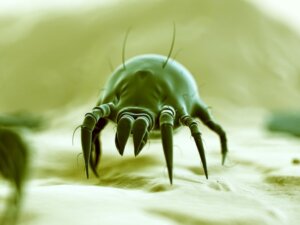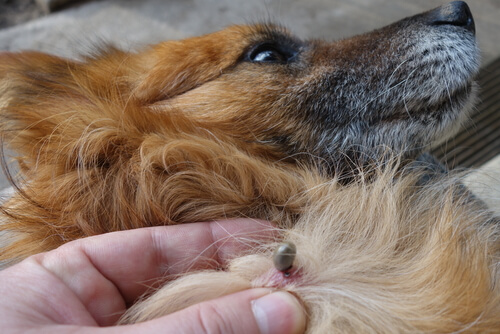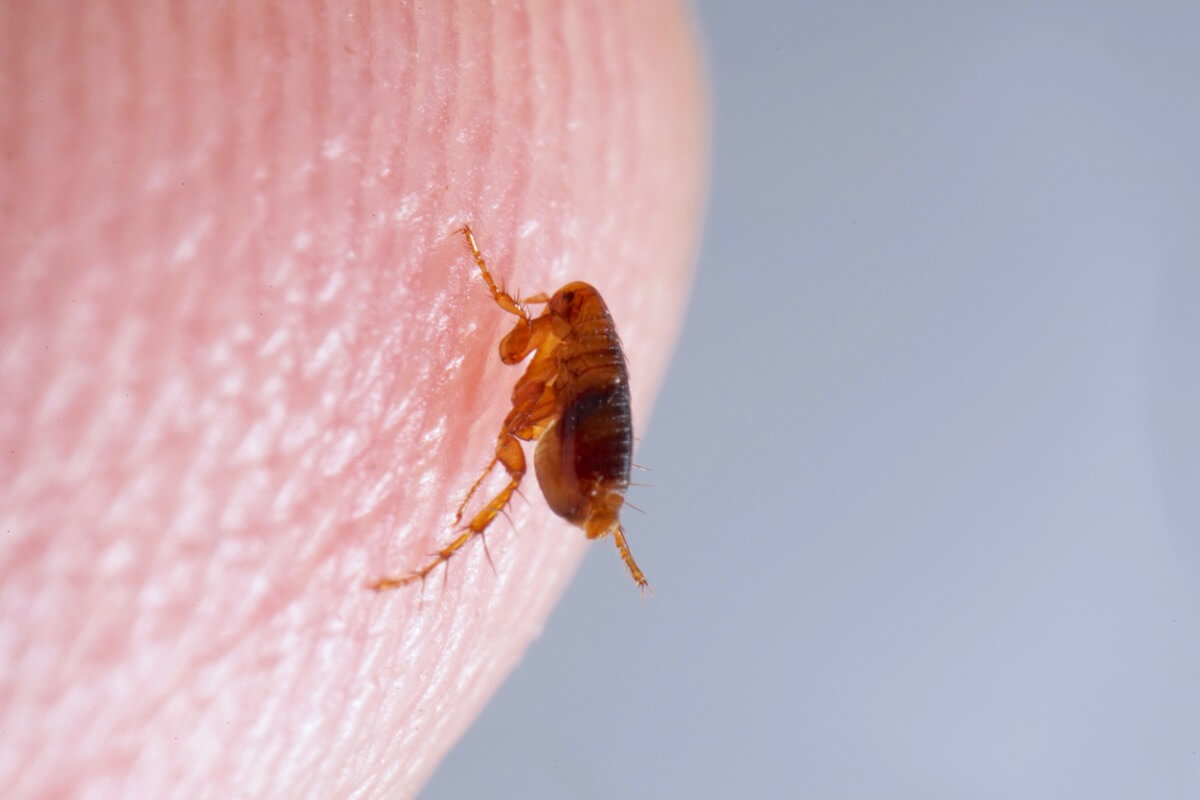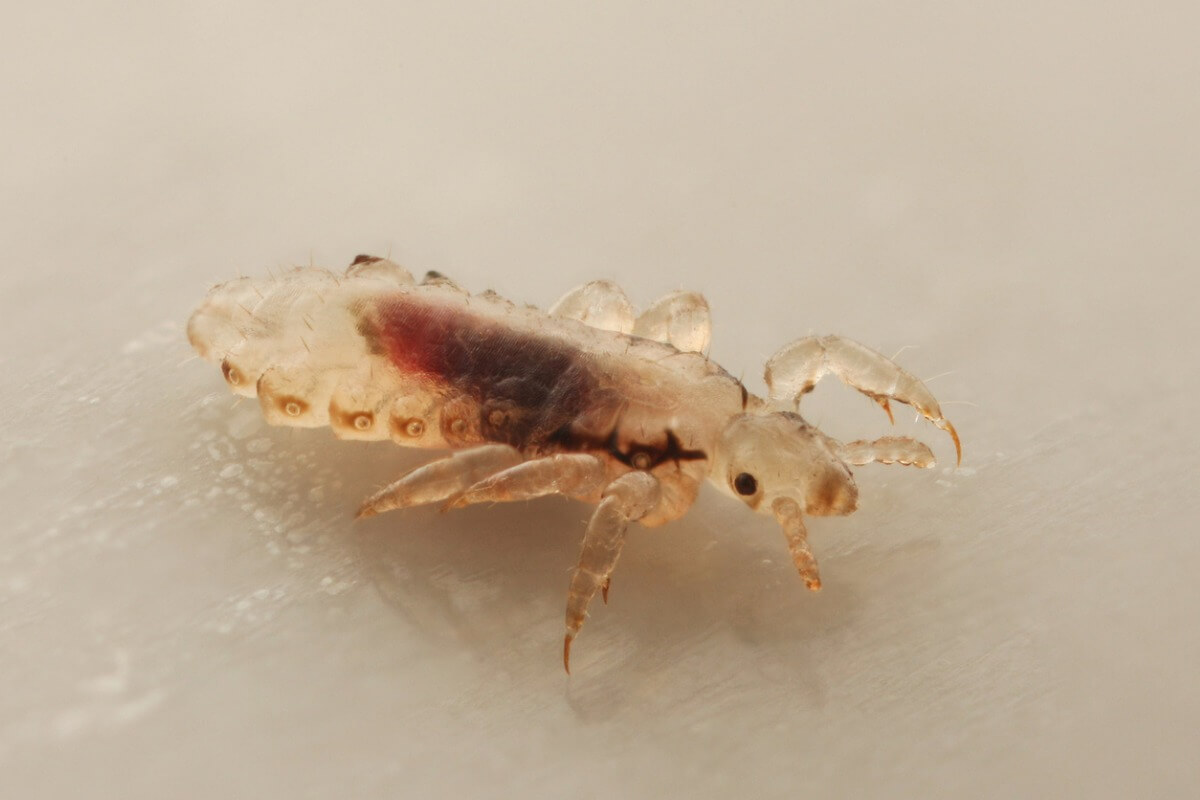Ectoparasites that Survive in Winter and Affect your Pets


Written and verified by the biologist Cesar Paul Gonzalez Gonzalez
Ectoparasites (external parasites) are one of the most common problems affecting pets. Although most of these pathological agents don’t usually cause serious health problems, they can produce quite annoying clinical signs. Therefore, it’s recommended to treat them as soon as possible to avoid affecting your pet’s daily life.
Because ectoparasites live in the fur or skin of their host, they’re exposed to climatic variations such as seasonal changes. Of course, the temperature often affects their metabolism, so not all of them are active at any given time of the year. Continue reading to discover which ectoparasites harm your pet in winter.
What is an ectoparasite?
External parasites, better known as ectoparasites, are pathogenic organisms that invade and infect an animal’s skin, fur, or feathers. They feed on the shed skin or blood of their host, causing direct lesions that become more intense as the infestation increases.
The external parasites that affect pets usually belong to two main taxonomic groups: insects (Insecta) and mites (Acari). These are characterized by their tiny size that’s often almost imperceptible, which makes it difficult to detect them.

What ectoparasites affect pets in the winter?
Most arthropods that act as pet parasites are ectotherms. This means that they’re unable to regulate their body heat, so they depend on environmental temperature to carry out their activities. Like reptiles, they perform best in warm or temperate climates.
Winter is a rather difficult time for ectoparasites, as low temperatures decrease their activity and reduce their metabolism. On top of that, because they live on the skin and fur of their hosts, they’re exposed to the cold environment almost all the time. This is the reason why few species of external parasites survive the winter and are able to infect a pet.
In order to withstand winter climates, these pathogens have developed several resistance strategies. Not all of them are efficient or ensure the survival of the specimens, but they’re enough to reduce their mortality rate and make the species persist. Some examples of ectoparasites that have some winter hardiness and that could affect your pet are as follows.
1. Fleas (Siphonaptera)
Fleas are a type of small insect known for their incredible jumping ability. They measure between 1.5 and 10 millimeters long, lack wings, have a laterally flattened body and feed on the blood of their hosts. They live between the pet’s skin and fur (or feathers), so they’re kept warm by the heat generated by the body.
There are several types of fleas and each has a preference for parasitizing a particular species. Despite this, they are capable of infesting several different animals (including humans) if there’s direct contact with an infected animal. The most relevant flea species are as follows:
- Ctenocephalides felis: a cat flea (but also affects dogs).
- Ctenocephalides canis: a dog flea.
- Xenopsylla cheopsis: a mouse flea.
- Echidnophaga gallinacea: a chicken flea.
The lesions caused by these insects are almost imperceptible. However, their saliva tends to cause an allergic reaction that inflames the area where they bite and causes itching. Although they don’t represent a danger to the pet, severe infestations can reduce the body’s defenses and even cause anemia. Therefore, it’s recommended to treat them as soon as possible.

Mites (Acari)
Mites are a taxonomic group characterized by their tiny size, imperceptible to the naked eye. They measure between 0.1 and 0.5 millimeters in length, are round and elongated, and have adapted to live within the outermost layer of the skin (stratum corneum). Thanks to the latter, they are protected from cold weather and are less affected by the winter season.
Contrary to other parasites, several species of mites live naturally on the skin of pets. However, the immune system regulates their population and keeps it in balance to prevent damage. When animals become sick or immunosuppressed, these parasites get “out of control” and cause redness, inflammation, dryness and alopecia (advanced cases).
Most mites are usually specialist parasites of a single host type. This means that infection cannot be spread between animals of different species, as is the case with fleas. The best-known species of these pathogens are the following:
- Chorioptes bovis: a cattle mange mite.
- Dermanysus gallinae: a chicken mite.
- Demodex canis: a dog mite.
- Demodex cati: a cat mite.
- Sarcoptes scabiei: a scabies mite (with variants for different animal species).
- Otodectes cynotis: an ear scabies mite (dogs and cats).
Ticks (Argasidae, Ixodidae and Nutellidae)
Ticks are round arthropods measuring between 3 and 10 millimeters in length. They are hematophagous and have modified mouthparts shaped like a toothed “drill”. This adaptation allows them to cut the skin and anchor firmly, making it difficult to remove them completely.
This taxonomic group is most abundant and diverse in temperate climates of the tropics. Despite this, certain species have evolved strategies to remain active even in the winter seasons. Although they don’t have the same efficiency as during the summer or spring, they’re one of the few external parasites that maintain the ability to infect the pet.
The presence of these ectoparasites causes minimal discomfort such as itching and inflammation, but this can be aggravated depending on the level of infestation. Although by themselves they don’t pose a risk to the hosts, their presence is conducive to secondary infections or inoculation of toxins. This is why immediate removal upon detection is recommended.
Ticks are also known to be vectors for the transmission of other dangerous pathologies, such as Lyme disease, ehrlichiosis, and babesiosis. Moreover, they don’t have specific hosts, so they’re capable of infecting both humans and pets. Among the most relevant species of the group are the following:
- Dermacentor nitens: a brown tick.
- Amblyomma cajennense: cayenne tick.
- Amblyomma variegatum: a tropical tick.
- Ixodes scapularis: a black-legged tick.
- Ixodes ricinus: a sheep tick.
- Ixodes holocyclus: Australian paralysis tick.
4. Lice (Phthiraptera)
Lice are a type of small, flattened insects that infest the skin of pets. They feed on skin debris, sebaceous secretions, and blood, depending on the nutritional needs of the species. Contrary to the previous parasites, this taxonomic group has a high host specialization, so it isn’t possible for them to infect different species of animals.
On the other hand, winter isn’t a problem for the development of lice, as their entire life cycle is carried out on the warm skin of their host. Also, as long as they remain in this location, their food resources are assured. Among the best-known species of lice are these:
- Polyplax serrata: mouse louse.
- Haemodipsus ventricosus: rabbit louse.
- Trichodectes canis: dog louse.
- Menacanthus stramineus: hen louse.
- Columbicola columbae: pigeon louse.

As you can see, there are several types of ectoparasites that can affect your pet’s skin during the winter. Although it isn’t a favorable season for these creatures, it’s best to maintain preventive measures all year round (flea collars, dewormers, etc.). By following these guidelines, your companion will be less likely to become infested and experience the typical discomfort of these pathogens.
Ectoparasites (external parasites) are one of the most common problems affecting pets. Although most of these pathological agents don’t usually cause serious health problems, they can produce quite annoying clinical signs. Therefore, it’s recommended to treat them as soon as possible to avoid affecting your pet’s daily life.
Because ectoparasites live in the fur or skin of their host, they’re exposed to climatic variations such as seasonal changes. Of course, the temperature often affects their metabolism, so not all of them are active at any given time of the year. Continue reading to discover which ectoparasites harm your pet in winter.
What is an ectoparasite?
External parasites, better known as ectoparasites, are pathogenic organisms that invade and infect an animal’s skin, fur, or feathers. They feed on the shed skin or blood of their host, causing direct lesions that become more intense as the infestation increases.
The external parasites that affect pets usually belong to two main taxonomic groups: insects (Insecta) and mites (Acari). These are characterized by their tiny size that’s often almost imperceptible, which makes it difficult to detect them.

What ectoparasites affect pets in the winter?
Most arthropods that act as pet parasites are ectotherms. This means that they’re unable to regulate their body heat, so they depend on environmental temperature to carry out their activities. Like reptiles, they perform best in warm or temperate climates.
Winter is a rather difficult time for ectoparasites, as low temperatures decrease their activity and reduce their metabolism. On top of that, because they live on the skin and fur of their hosts, they’re exposed to the cold environment almost all the time. This is the reason why few species of external parasites survive the winter and are able to infect a pet.
In order to withstand winter climates, these pathogens have developed several resistance strategies. Not all of them are efficient or ensure the survival of the specimens, but they’re enough to reduce their mortality rate and make the species persist. Some examples of ectoparasites that have some winter hardiness and that could affect your pet are as follows.
1. Fleas (Siphonaptera)
Fleas are a type of small insect known for their incredible jumping ability. They measure between 1.5 and 10 millimeters long, lack wings, have a laterally flattened body and feed on the blood of their hosts. They live between the pet’s skin and fur (or feathers), so they’re kept warm by the heat generated by the body.
There are several types of fleas and each has a preference for parasitizing a particular species. Despite this, they are capable of infesting several different animals (including humans) if there’s direct contact with an infected animal. The most relevant flea species are as follows:
- Ctenocephalides felis: a cat flea (but also affects dogs).
- Ctenocephalides canis: a dog flea.
- Xenopsylla cheopsis: a mouse flea.
- Echidnophaga gallinacea: a chicken flea.
The lesions caused by these insects are almost imperceptible. However, their saliva tends to cause an allergic reaction that inflames the area where they bite and causes itching. Although they don’t represent a danger to the pet, severe infestations can reduce the body’s defenses and even cause anemia. Therefore, it’s recommended to treat them as soon as possible.

Mites (Acari)
Mites are a taxonomic group characterized by their tiny size, imperceptible to the naked eye. They measure between 0.1 and 0.5 millimeters in length, are round and elongated, and have adapted to live within the outermost layer of the skin (stratum corneum). Thanks to the latter, they are protected from cold weather and are less affected by the winter season.
Contrary to other parasites, several species of mites live naturally on the skin of pets. However, the immune system regulates their population and keeps it in balance to prevent damage. When animals become sick or immunosuppressed, these parasites get “out of control” and cause redness, inflammation, dryness and alopecia (advanced cases).
Most mites are usually specialist parasites of a single host type. This means that infection cannot be spread between animals of different species, as is the case with fleas. The best-known species of these pathogens are the following:
- Chorioptes bovis: a cattle mange mite.
- Dermanysus gallinae: a chicken mite.
- Demodex canis: a dog mite.
- Demodex cati: a cat mite.
- Sarcoptes scabiei: a scabies mite (with variants for different animal species).
- Otodectes cynotis: an ear scabies mite (dogs and cats).
Ticks (Argasidae, Ixodidae and Nutellidae)
Ticks are round arthropods measuring between 3 and 10 millimeters in length. They are hematophagous and have modified mouthparts shaped like a toothed “drill”. This adaptation allows them to cut the skin and anchor firmly, making it difficult to remove them completely.
This taxonomic group is most abundant and diverse in temperate climates of the tropics. Despite this, certain species have evolved strategies to remain active even in the winter seasons. Although they don’t have the same efficiency as during the summer or spring, they’re one of the few external parasites that maintain the ability to infect the pet.
The presence of these ectoparasites causes minimal discomfort such as itching and inflammation, but this can be aggravated depending on the level of infestation. Although by themselves they don’t pose a risk to the hosts, their presence is conducive to secondary infections or inoculation of toxins. This is why immediate removal upon detection is recommended.
Ticks are also known to be vectors for the transmission of other dangerous pathologies, such as Lyme disease, ehrlichiosis, and babesiosis. Moreover, they don’t have specific hosts, so they’re capable of infecting both humans and pets. Among the most relevant species of the group are the following:
- Dermacentor nitens: a brown tick.
- Amblyomma cajennense: cayenne tick.
- Amblyomma variegatum: a tropical tick.
- Ixodes scapularis: a black-legged tick.
- Ixodes ricinus: a sheep tick.
- Ixodes holocyclus: Australian paralysis tick.
4. Lice (Phthiraptera)
Lice are a type of small, flattened insects that infest the skin of pets. They feed on skin debris, sebaceous secretions, and blood, depending on the nutritional needs of the species. Contrary to the previous parasites, this taxonomic group has a high host specialization, so it isn’t possible for them to infect different species of animals.
On the other hand, winter isn’t a problem for the development of lice, as their entire life cycle is carried out on the warm skin of their host. Also, as long as they remain in this location, their food resources are assured. Among the best-known species of lice are these:
- Polyplax serrata: mouse louse.
- Haemodipsus ventricosus: rabbit louse.
- Trichodectes canis: dog louse.
- Menacanthus stramineus: hen louse.
- Columbicola columbae: pigeon louse.

As you can see, there are several types of ectoparasites that can affect your pet’s skin during the winter. Although it isn’t a favorable season for these creatures, it’s best to maintain preventive measures all year round (flea collars, dewormers, etc.). By following these guidelines, your companion will be less likely to become infested and experience the typical discomfort of these pathogens.
All cited sources were thoroughly reviewed by our team to ensure their quality, reliability, currency, and validity. The bibliography of this article was considered reliable and of academic or scientific accuracy.
- Lareschi, M., & Drago, F. B. (2017). Artrópodos ectoparásitos. Colección: Libros de Cátedra.
- Consejo Europeo para el Control de las Parasitosis de los Animales de Compañía. (2016). Control de ectoparásitos en perros y gatos. Primera Edición ESCCAP.
- Pulido-Villamarín, A. D. P., Castañeda-Salazar, R., Ibarra-Ávila, H., Gómez-Méndez, L. D., & Barbosa-Buitrago, A. M. (2016). Microscopía y principales características morfológicas de algunos ectoparásitos de interés veterinario. Revista de Investigaciones Veterinarias del Perú, 27(1), 91-113.
- Poje, J. E., Rocke, T. E., & Samuel, M. D. (2020). Impacts of environmental conditions on fleas in black‐tailed prairie dog burrows. Journal of Vector Ecology, 45(2), 356-365.
- Dobler, G., & Pfeffer, M. (2011). Fleas as parasites of the family Canidae. Parasites & Vectors, 4, 1-12.
- Tropical Council for Companion Animal Parasites. (2022). Directrices para el control de ectoparásitos de perros y gatos en los trópicos. TroCCAP. Recuperado el 6 de marzo de 2023, disponible en: https://www.troccap.com/wp-content/uploads/2022/05/Spanish_ecto_v1.pdf
- Mosallanejad, B., Alborzi, A. R., & Katvandi, N. (2012). A survey on ectoparasite infestations in companion dogs of Ahvaz district, south-west of Iran. Journal of arthropod-borne diseases, 6(1), 70-78.
- Jamshidi, S., Maazi, N., Ranjbar-Bahadori, S., Rezaei, M., Morakabsaz, P., & Hosseininejad, M. (2012). A survey of ectoparasite infestation in dogs in Tehran, Iran. Revista brasileira de parasitologia veterinaria, 21, 326-329.
This text is provided for informational purposes only and does not replace consultation with a professional. If in doubt, consult your specialist.








